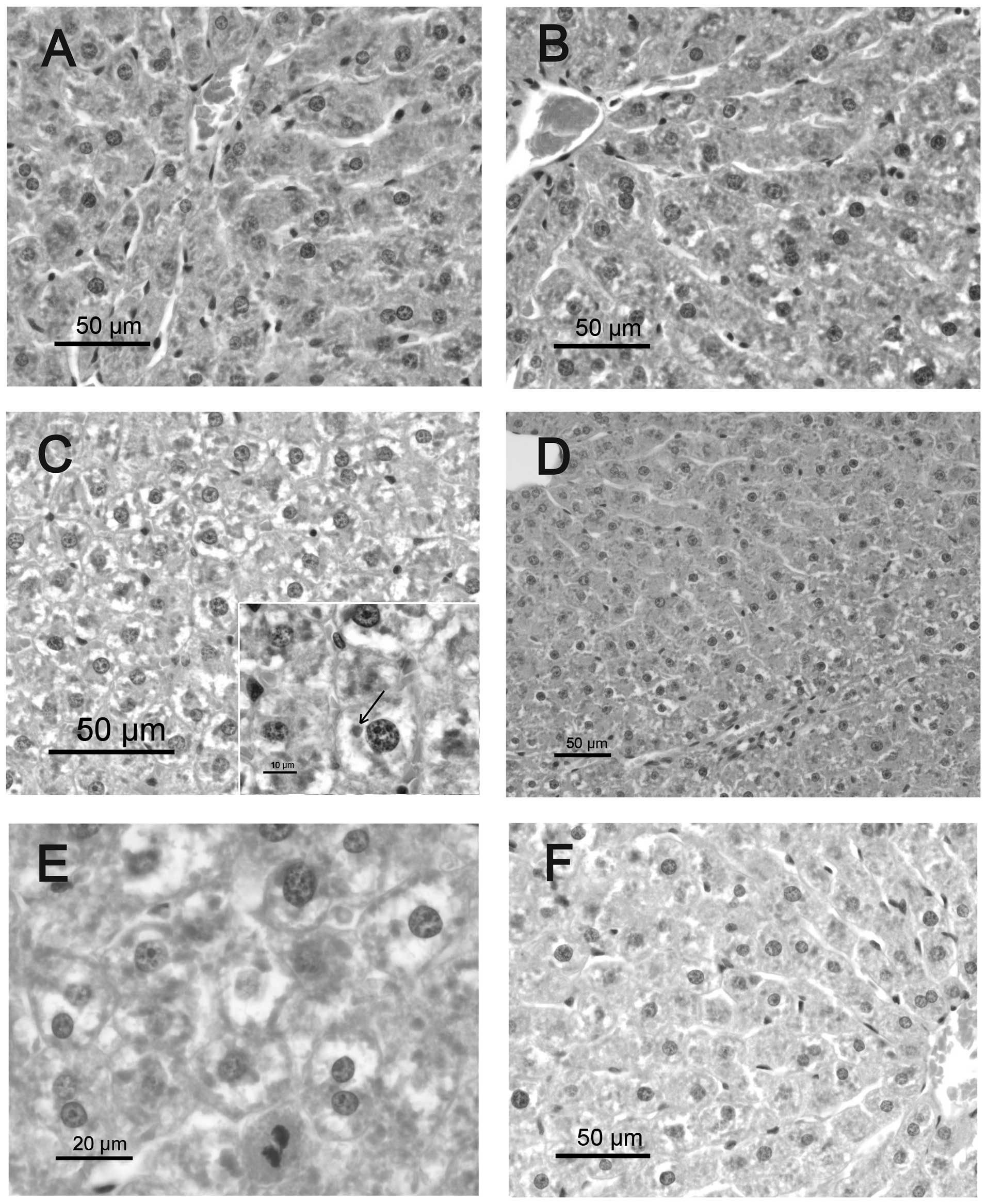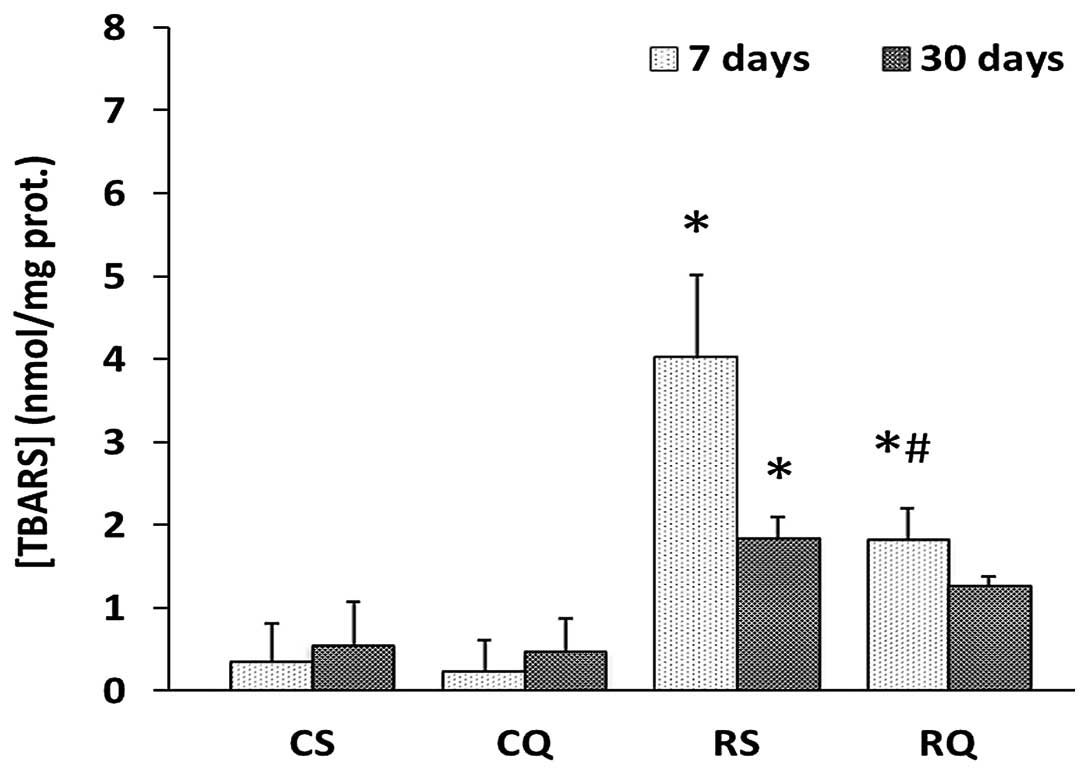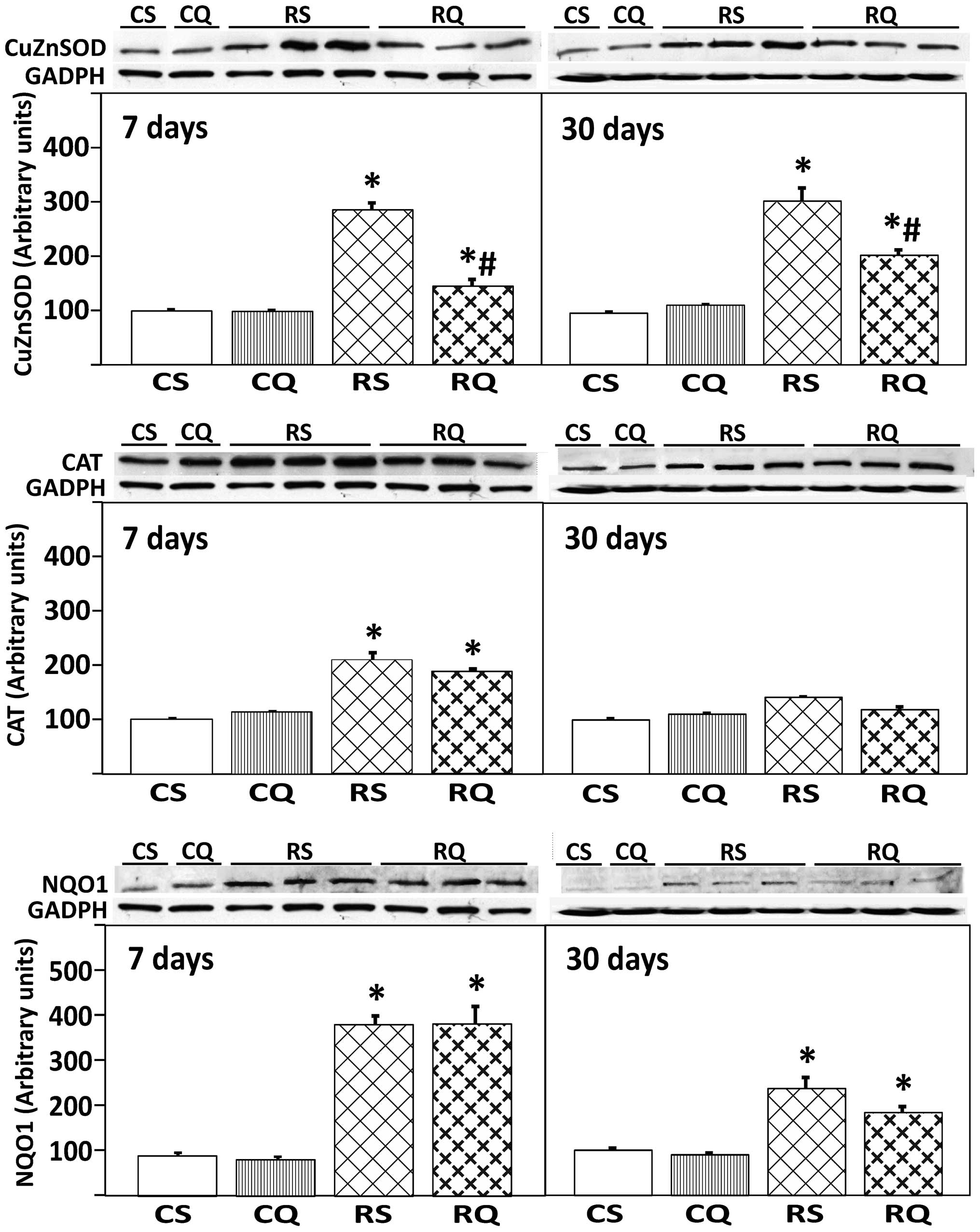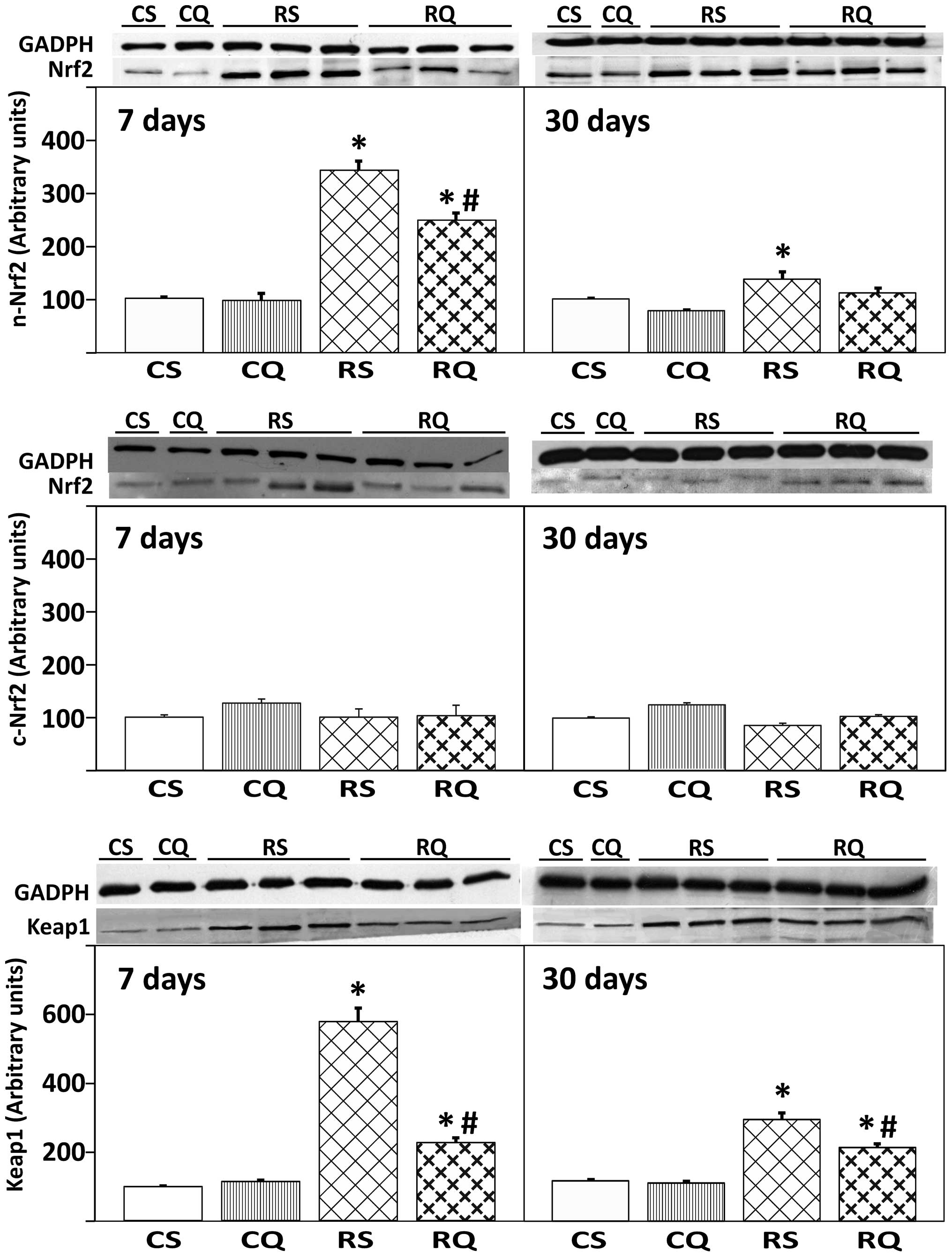|
1
|
Tanigawa S, Fujii M and Hou D: Action of
Nrf2 and Keap1 in ARE-mediated NQO1 expression by quercetin. Free
Rad Biol Med. 42:1690–1703. 2007. View Article : Google Scholar : PubMed/NCBI
|
|
2
|
Aleksunes LM and Manautou JE: Emerging
role of Nrf2 in protecting against hepatic and gastrointestinal
disease. Toxicol Pathol. 35:459–473. 2007. View Article : Google Scholar : PubMed/NCBI
|
|
3
|
Middleton EJ, Kandaswami C and Theoharides
T: The effects of plants flavonoids on mammalian cells:
implications for inflammation, heart disease, and cancer. Pharmacol
Rev. 52:673–751. 2000.PubMed/NCBI
|
|
4
|
González-Gallego J, García-Mediavilla MV,
Sánchez-Campos S and Tuñón MJ: Fruit polyphenols, immunity and
inflammation. Br J Nutr. 104:S15–S27. 2010.PubMed/NCBI
|
|
5
|
Hosseinimehr SJ: Trends in the development
of radioprotective agents. Drug Discov Today. 12:794–805. 2007.
View Article : Google Scholar
|
|
6
|
Otsuka K, Koana T, Tauchi H and Sakai K:
Activation of antioxidative enzymes induced by low-dose-rate
whole-body gamma irradiation: adaptive response in terms of initial
DNA damage. Radiat Res. 166:474–478. 2006. View Article : Google Scholar : PubMed/NCBI
|
|
7
|
Okunieff P, Swarts S, Keng P, et al:
Antioxidants reduce consequences of radiation exposure. Adv Exp Med
Biol. 614:165–178. 2008. View Article : Google Scholar : PubMed/NCBI
|
|
8
|
Marnett LJ: Oxy radicals, lipid
peroxidation and DNA damage. Toxicology. 181–182:219–222.
2002.PubMed/NCBI
|
|
9
|
Wallace DC: The mitochondrial genome in
human adaptive radiation and disease: on the road to therapeutics
and performance enhancement. Gene. 354:169–180. 2005. View Article : Google Scholar : PubMed/NCBI
|
|
10
|
Nwokocha CR, Nwokocha M, Mounmbegna P, et
al: Proteins and liver function changes in rats following
cumulative total body irradiations. West Indian Med J. 61:773–777.
2012.PubMed/NCBI
|
|
11
|
Citrin D, Cotrim AP, Hyodo F, et al:
Radioprotectors and mitigators of radiation-induced normal tissue
injury. Oncologist. 15:360–371. 2010. View Article : Google Scholar : PubMed/NCBI
|
|
12
|
Kawai Y, Saito S, Nishikawa T, et al:
Different profiles of quercetin metabolites in rat plasma:
comparison of two administration methods. Biosci Biotechnol
Biochem. 73:517–523. 2009. View Article : Google Scholar : PubMed/NCBI
|
|
13
|
Willis ED: Evaluation of lipid
peroxidation in lipids and biological membranes. Biochemical
Toxicology: A Practical Approach. Snell KB and Mullock B: IRL
Press; Oxford: pp. 407–420. 1987
|
|
14
|
Jung JH, Kang JI and Kim HS: Effect of
quercetin on impaired immune function in mice exposed to
irradiation. Nutr Res Pract. 6:301–307. 2012. View Article : Google Scholar : PubMed/NCBI
|
|
15
|
Kanter M, Aktas C and Erboga M: Protective
effects of quercetin against apoptosis and oxidative stress in
streptozotocin-induced diabetic rat testis. Food Chem Toxicol.
50:719–25. 2012. View Article : Google Scholar
|
|
16
|
Benkovic V, Knezevic AH, Dikic D, et al:
Radioprotective effects of quercetin and ethanolic extract of
propolis in gamma-irradiated mice. Arh Hig Rada Toksikol.
60:129–138. 2009. View Article : Google Scholar : PubMed/NCBI
|
|
17
|
Sezer A, Usta U, Kozak Z and Yagci MA: The
effect of a flavonoid fractions diosmin + hesperidin on
radiation-induced acute proctitis in a rat model. J Cancer Res
Ther. 7:152–156. 2011. View Article : Google Scholar : PubMed/NCBI
|
|
18
|
An JH, Kim J and Seong J: Redox signaling
by ionizing radiation in mouse liver. Ann NY Acad Sci. 1030:86–94.
2004. View Article : Google Scholar : PubMed/NCBI
|
|
19
|
Cromheecke M, Konings AW, Szabo BG and
Hoekstra HJ: Liver tissue tolerance for irradiation: experimental
and clinical investigations. Hepatogastroenterology. 47:1732–4170.
2000.PubMed/NCBI
|
|
20
|
Alati T, Van Cleef M, Strom SC and Jirtle
RL: Radiation sensitivity of adult human parenchymal hepatocytes.
Radiat Res. 115:152–160. 1988. View
Article : Google Scholar : PubMed/NCBI
|
|
21
|
Pei RJ, Danbara N, Tsujita-Kyutoku M, et
al: Immunohistochemical profiles of Mallory body by a panel of
anti-cytokeratin antibodies. Med Electron Microsc. 37:114–118.
2004.PubMed/NCBI
|
|
22
|
Bhosle SM, Huilgol NG and Mishra KP:
Enhancement of radiation-induced oxidative stress and cytotoxicity
in tumor cells by ellagic acid. Clin Chim Acta. 359:89–100. 2005.
View Article : Google Scholar : PubMed/NCBI
|
|
23
|
Karran P: DNA double strand break repair
in mammalian cells. Curr Opin Genetics Dev. 10:144–150. 2000.
View Article : Google Scholar : PubMed/NCBI
|
|
24
|
Andrade ER, Cruz IB, Andrade VV, et al:
Evaluation of the potential protective effects of ad libitum black
grape juice against liver oxidative damage in whole-body acute
X-irradiated rats. Food Chem Toxicol. 49:1026–1032. 2011.
View Article : Google Scholar : PubMed/NCBI
|
|
25
|
Meydan D, Gursel B, Bilgici B, Can B and
Ozbek N: Protective effect of lycopene against radiation-induced
hepatic toxicity in rats. J Int Med Res. 39:1239–1252. 2011.
View Article : Google Scholar : PubMed/NCBI
|
|
26
|
Tsukimoto M, Tamaishi N, Homma T and
Kojima S: Low-dose gamma-ray irradiation induced translocation of
Nrf2 into nuclear in mouse macrophague RAW264.7. J Radiat Res.
51:349–353. 2010. View Article : Google Scholar : PubMed/NCBI
|
|
27
|
McDonald JT, Kim K, Norris AJ, et al:
Ionizing radiation activates the Nrf2 antioxidant response. Cancer
Res. 70:8886–8895. 2010. View Article : Google Scholar : PubMed/NCBI
|
|
28
|
Liu Y, Zhang L, Zhang H, et al: Exogenous
melatonin modulates apoptosis in the mouse brain induced by
high-LET carbon ion irradiation. J Pineal Res. 52:47–56. 2012.
View Article : Google Scholar : PubMed/NCBI
|
|
29
|
Jung KH, Hong SW, Zheng HM, Lee DH and
Hong SS: Melatonin downregulates nuclear erythroid 2-related factor
2 and nuclear factor-kappaB during prevention of oxidative liver
injury in a dimethylnitrosamine model. J Pineal Res. 47:173–183.
2009. View Article : Google Scholar
|
|
30
|
Li W, Khor TO, Xu C, et al: Activation of
Nrf2-antioxidant signaling attenuates NFkappaB-inflammatory
response and elicits apoptosis. Biochem Pharmacol. 76:1485–1489.
2008. View Article : Google Scholar : PubMed/NCBI
|
|
31
|
Lee OH, Jain AK, Papusha V and Jaiswal AK:
An auto-regulatory loop between stress sensors INrf2 and Nrf2
controls their cellular abundance. J Biol Chem. 282:36412–36420.
2007. View Article : Google Scholar : PubMed/NCBI
|
|
32
|
Milani P, Gagliardi S, Cova E and Cereda
C: SOD1 Transcriptional and Posttranscriptional Regulation and Its
Potential Implications in ALS. Neurol Res Int.
2011:4584272011.PubMed/NCBI
|
|
33
|
Park EY and Rho HM: The transcriptional
activation of the human copper/zinc superoxide dismutase gene by
2,3,7,8-tetrachlorodibenzo-p-dioxin through two different regulator
sites, the antioxidant responsive element and xenobiotic responsive
element. Mol Cell Biochem. 240:47–55. 2002. View Article : Google Scholar
|
|
34
|
Terakado N, Shintani S, Nakahara Y, et al:
Expression of Cu/Zn-SOD, Mn-SOD and GST-pi in oral cancer treated
with preoperative radiation therapy. Oncol Rep. 7:1113–1117.
2000.PubMed/NCBI
|
|
35
|
Vucic V, Isenovic ER, Adzic M, Ruzdijic S
and Radojcic MB: Effects of gamma-radiation on cell growth, cycle
arrest, death, and superoxide dismutase expression by DU 145 human
prostate cancer cells. Braz J Med Biol Res. 39:227–236. 2006.
View Article : Google Scholar : PubMed/NCBI
|
|
36
|
Boots AW, Bast A and Haenen GR: No role of
DT-diaphorase (NQO1) in the protection against oxidized quercetin.
FEBS Lett. 579:677–82. 2005. View Article : Google Scholar : PubMed/NCBI
|
|
37
|
Orlowski RZ and Baldwin AS Jr: NF-kappaB
as a therapeutic target in cancer. Trends Mol Med. 8:385–389. 2002.
View Article : Google Scholar : PubMed/NCBI
|
|
38
|
Bravard A, Luccioni C, Moustacchi E and
Rigaud O: Contribution of antioxidant enzymes to the adaptative
response to ionizing radiation of human lymphoblasts. Int J Radiat
Biol. 75:639–645. 1999. View Article : Google Scholar : PubMed/NCBI
|
|
39
|
Crespo I, Garcia-Mediavilla MV, Almar M,
et al: Differential effects of dietary flavonoids on reactive
oxygen and nitrogen species generation and changes in antioxidant
enzyme expression induced by proinflammatory cytokines in Chang
Liver cells. Food Chem Toxicol. 46:1555–1569. 2008. View Article : Google Scholar
|
|
40
|
Kook D, Wolf AH, Yu AL, et al: The
protective effect of quercetin against oxidative stress in the
human RPE in vitro. Invest Ophthalmol Vis Sci. 49:1712–1720. 2008.
View Article : Google Scholar : PubMed/NCBI
|
|
41
|
Duthie G and Morrice P: Antioxidant
capacity of flavonoids in hepatic microsomes is not reflected by
antioxidant effects in vivo. Oxid Med Cell Longev.
2012:1651272012.PubMed/NCBI
|
|
42
|
Nakamura Y, Ishimitsu S and Tonogai Y:
Effects of quercetin and rutin on serum and hepatic lipid
concentrations, fecal steroid excretion and serum antioxidant
properties. J Health Sci. 46:229–240. 2000. View Article : Google Scholar
|
|
43
|
Wang XJ, Sun Z, Villeneuve NF, et al: Nrf2
enhances resistance of cancer cells to chemotherapeutic drugs, the
dark side of Nrf2. Carcinogenesis. 29:1235–1243. 2008. View Article : Google Scholar : PubMed/NCBI
|
|
44
|
Lin C, Yu Y, Zhao HG, et al: Combination
of quercetin with radiotherapy enhances tumor radiosensitivity in
vitro and in vivo. Radiother Oncol. 104:395–400. 2012. View Article : Google Scholar : PubMed/NCBI
|













